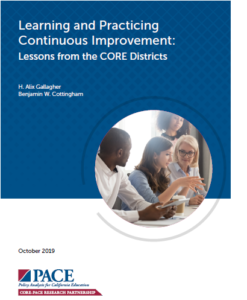Lessons Learned about Advancing Equity and Excellence through Continuous Improvement Efforts in California and New York State
By Kristen C. Wilcox
A recent Learning Policy Institute brief on the Every Student Succeeds Act (ESSA) points out that ESSA “… provides states with significant policymaking opportunity and responsibility and creates new levers for advancing equity and excellence throughout the nation’s schools”. Yet, the question remains: What mechanisms are in place to coordinate the efforts of state agency professionals, education researchers, district and school leaders, and teachers and support staff to push strategic levers for system-wide continuous improvement?
NYKids provides one model for continuous school improvement that bridges between and across organizations, all with shared concerns for improving children’s experiences in school and closing opportunity gaps. Like other research-practice partnerships, NYKids acts as a hub for continuous improvement by generating practice-relevant research; disseminating that research through reports, presentations, and social media; and offering direct continuous improvement support. To do this, NYKids works in collaboration with practicing professionals as partners in attacking root causes for variability in student performance outcomes, adapting innovations in light of local needs, and monitoring outcomes.
Spreading and scaling improvement: Sharing and comparing lessons learned about continuous improvement partnerships
Lessons learned by NYKids staff engaging in continuous improvement work resonate with lessons in other organizations across the country. For example, in an October 2019 report “Learning and Practicing Continuous Improvement: Lessons from the CORE Districts” Policy Analysis for California Education (PACE) describes the launching of a research partnership with the CORE Districts in California. As the authors of the report explain, “The CORE-PACE Research Partnership is focused on producing research that informs continuous improvement in the CORE districts and policy and practice in California and beyond.”
In their report they describe the following lessons about how best to utilize research and practice knowledge in service of addressing outcome disparities.
What do we know about how to support educators in learning continuous improvement?
Lesson 1: Embedding continuous improvement processes into the existing norms of schools is complex work; approaches to teaching it need to include cycles of practice and feedback to help educators apply complicated ideas in their own local contexts.
Lesson 2: Participating in a series of workshops rarely provides people the depth of knowledge necessary to lead or teach continuous improvement.
Lesson 3: Improvement teams need access to content area expertise as well as continuous improvement expertise.
What conditions support continuous improvement in districts and schools?
Lesson 4: Leaders used four key leadership moves to build an organization in which continuous improvement can thrive.
Lesson 5: Districts can take deliberate steps to build a culture conducive to continuous improvement.
Lesson 6: Structures and processes to break down silos and share information across organizational units do not inherently create continuous improvement, but they are foundational components that can support or hinder its progress.
NYKids Leveraging Partnerships and Odds-beating School Research as Resources for Continuous Improvement
One of the assets of NYKids’ own brand of direct support for continuous improvement is called COMPASS— an acronym for an improvement-science based process of 1. Comparing practices to positive outliers (i.e. odds-beaters), 2. Assessing user priorities and resources, 3. Selecting levers to improve (i.e. drivers), 4. Setting SMART goals and aims.
- With the same findings as the CORE-PACE researchers with regard to lessons 1 ,2, and 3, NYKids staff have realized that significant movement toward becoming an improving organization requires sustained engagement and disciplined work. So NYKids, in partnership with Capital Area School Development Association (an organization that offers a wide variety of content expertise), assists district and school leaders, teachers, and support staff to work in continuous improvement teams. With guidance from NYKids improvement specialists, the school-based teams work on targeted improvement projects over entire school years. When possible these teams are connected with others across schools and districts.
- A unique feature of COMPASS with regard to lessons 4,5, and 6, is the use of positive outliers (or what we call odds-beaters) to address the diffusion of knowledge across schools in New York state. This feature of NYKids focuses on using practical knowledge from the field to generate change ideas for others.
Beyond ESSA: Advancing Equity and Excellence by Building a Continuous Improvement Infrastructure
ESSA’s provisions for new ways of assessing student performance to include attention to deeper learning indicators, as well as focusing on teacher quality and better distribution and monitoring of resource allocations, are steps in the right direction toward fostering conditions for continuous improvement.
Still, lessons learned from organizations like CORE-PACE and NYKids point to the need for state agency professionals, education researchers, district and school leaders, and teachers and support staff to work in synchronicity with each other to generate, diffuse, and use knowledge more efficiently.
One of the best ways to learn more about how continuous improvement is done can be gleaned from case studies. See case study examples from CORE and NYKids and stay tuned for presentations from NYKids on new developments in forwarding the scholarship of improvement at the upcoming University Council for Educational Administration (UCEA) convention in late November.

